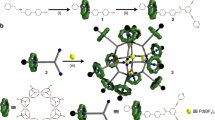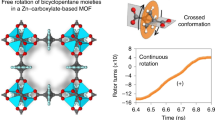Abstract
The tetravalency of carbon and its ability to form covalent bonds with itself and other elements enables large organic molecules with complex structures, functions and dynamics to be constructed. The varied electronic configurations and bonding patterns of inorganic elements, on the other hand, can impart diverse electronic, magnetic, catalytic and other useful properties to molecular-level structures. Some hybrid organic–inorganic materials that combine features of both chemistries have been developed, most notably metal–organic frameworks1, dense and extended organic–inorganic frameworks2 and coordination polymers3. Metal ions have also been incorporated into molecules that contain interlocked subunits, such as rotaxanes4,5,6,7 and catenanes6,8, and structures in which many inorganic clusters encircle polymer chains have been described9. Here we report the synthesis of a series of discrete rotaxane molecules in which inorganic and organic structural units are linked together mechanically at the molecular level. Structural units (dialkyammonium groups) in dumb-bell-shaped organic molecules template the assembly of essentially inorganic ‘rings’ about ‘axles’ to form rotaxanes consisting of various numbers of rings and axles. One of the rotaxanes behaves as a ‘molecular shuttle’10: the ring moves between two binding sites on the axle in a large-amplitude motion typical of some synthetic molecular machine systems11,12,13,14,15. The architecture of the rotaxanes ensures that the electronic, magnetic and paramagnetic characteristics of the inorganic rings—properties that could make them suitable as qubits for quantum computers16,17,18—can influence, and potentially be influenced by, the organic portion of the molecule.
This is a preview of subscription content, access via your institution
Access options
Subscribe to this journal
Receive 51 print issues and online access
$199.00 per year
only $3.90 per issue
Buy this article
- Purchase on Springer Link
- Instant access to full article PDF
Prices may be subject to local taxes which are calculated during checkout




Similar content being viewed by others
References
Yaghi, O. M. et al. Reticular synthesis and the design of new materials. Nature 423, 705–714 (2003)
Cheetham, A. K. & Rao, C. N. R. There’s room in the middle. Science 318, 58–59 (2007)
Kitagawa, S., Kitaura, R. & Noro, S.-i. Functional porous coordination polymers. Angew. Chem. Int. Edn 43, 2334–2375 (2004)
Ogino, H. Relatively high-yield syntheses of rotaxanes. Syntheses and properties of compounds consisting of cyclodextrins threaded by α, ω-diaminoalkanes coordinated to cobalt(III) complexes. J. Am. Chem. Soc. 103, 1303–1304 (1981)
Batten, S. R. & Robson, R. Interpenetrating nets: ordered, periodic entanglement. Angew. Chem. Int. Edn 37, 1460–1494 (1998)
Sauvage, J.-P. & Dietrich-Buchecker, C. (eds) Molecular Catenanes, Rotaxanes and Knots: A Journey through the World of Molecular Topology (Wiley-VCH, 1999)
Loeb, S. J. Metal organic rotaxane frameworks. Chem. Commun. 1511–1518 (2005)
Fujita, M., Ibukuro, F., Hagihara, H. & Ogura, K. Quantitative self-assembly of a [2]catenane from two preformed molecular rings. Nature 367, 720–723 (1994)
Alam, M. A. et al. Directed 1D assembly of a ring-shaped inorganic nanocluster templated by an organic rigid-rod molecule. Angew. Chem. Int. Edn 47, 2070–2073 (2008)
Anelli, P. L., Spencer, N. & Stoddart, J. F. A molecular shuttle. J. Am. Chem. Soc. 113, 5131–5133 (1991)
Berná, J. et al. Macroscopic transport by synthetic molecular machines. Nature Mater. 4, 704–710 (2005)
Nguyen, T. et al. A reversible molecular valve. Proc. Natl Acad. Sci. USA 102, 10029–10034 (2005)
Liu, Y. et al. Linear artificial molecular muscles. J. Am. Chem. Soc. 127, 9745–9759 (2005)
Green, J. E. et al. A 160-kilobit molecular electronic memory patterned at 1011 bits per square centimetre. Nature 445, 414–417 (2007)
Kay, E. R., Leigh, D. A. & Zerbetto, F. Synthetic molecular motors and mechanical machines. Angew. Chem. Int. Edn 46, 72–191 (2007)
Leuenberger, M. N. & Loss, D. Quantum computing in molecular magnets. Nature 410, 789–793 (2001)
Bertaina, S. et al. Quantum oscillations in a molecular magnet. Nature 453, 203–206 (2008)
Winpenny, R. E. P. Quantum information processing using molecular nanomagnets as qubits. Angew. Chem. Int. Edn 47, 7992–7994 (2008)
Larsen, F. K. et al. Synthesis and characterization of heterometallic {Cr7M} wheels. Angew. Chem. Int. Edn 42, 101–105 (2003)
Affronte, M., Carretta, S., Timco, G. A. & Winpenny, R. E. P. A ring cycle: studies of heterometallic wheels. Chem. Commun. 1789–1797 (2007)
Timco, G. A. et al. Influencing the nuclearity and constitution of heterometallic rings via templates. Chem. Commun. 3649–3651 (2005)
Cador, O. et al. The magnetic Möbius strip: synthesis, structure and magnetic studies of odd-numbered antiferromagnetically coupled wheels. Angew. Chem. Int. Edn 43, 5196–5200 (2004)
Kolchinski, A. G., Busch, D. H. & Alcock, N. W. Gaining control over molecular threading: benefits of second coordination sites and aqueous–organic interfaces in rotaxane synthesis. J. Chem. Soc. Chem. Commun. 1289–1291 (1995)
Ashton, P. R. et al. Self-assembling [2]- and [3]rotaxanes from secondary dialkylammonium salts and crown ethers. Chem. Eur. J. 2, 729–736 (1996)
Mock, W. L., Irra, T. A., Wepsiec, J. P. & Adhia, M. Catalysis by cucurbituril. The significance of bound-substrate destabilization for induced triazole formation. J. Org. Chem. 54, 5302–5308 (1989)
Kim, K. Mechanically interlocked molecules incorporating cucurbituril and their supramolecular assemblies. Chem. Soc. Rev. 31, 96–107 (2002)
Aucagne, V., Leigh, D. A., Lock, J. S. & Thomson, A. R. Rotaxanes of cyclic peptides. J. Am. Chem. Soc. 128, 1784–1785 (2006)
Ashton, P. R. et al. Doubly encircled and double-stranded pseudorotaxanes. Angew. Chem. Int. Edn Engl. 34, 1869–1871 (1995)
Perrin, C. L. & Dwyer, T. J. Application of two-dimensional NMR to kinetics of chemical exchange. Chem. Rev. 90, 935–967 (1990)
Acknowledgements
We thank J. Bella for the exchange spectroscopy NMR experiments, W. Sun for assistance with the preparation of thread 1c and the Engineering and Physical Sciences Research Council (EPSRC) National Mass Spectrometry Service Centre (Swansea, UK) for high-resolution mass spectrometry. This research was funded by the European Commission (through the NoE ‘MAGMANet’) and EPSRC. The Advanced Light Source is supported by the Director, Office of Science, Office of Basic Energy Sciences, of the US Department of Energy under contract no. DE-AC02-05CH11231. D.S. is a Swiss National Science Foundation postdoctoral fellow. D.A.L. is an EPSRC Senior Research Fellow and holds a Royal Society Wolfson Research Merit Award.
Author Contributions C.-F.L., D.S. and G.A.T. carried out the synthesis and characterization studies, helped plan the experiments and participated in the preparation of the manuscript. R.G.P. and S.J.T. collected the X-ray data and solved the crystal structures. D.A.L. and R.E.P.W. helped plan the experiments and prepare the manuscript.
Author information
Authors and Affiliations
Corresponding authors
Additional information
The crystallographic data and experimental details of the structural refinement for the X-ray crystal structures reported in this paper have been deposited at the Cambridge Crystallographic Data Centre, under deposition numbers CCDC 705132–CCDC 705135. These data can be obtained free of charge from the Cambridge Crystallographic Data Centre (http://www.ccdc.cam.ac.uk/data_request/cif).
Supplementary information
Supplementary Information
This file contains Supplementary Notes, Supplementary Figures S1-S11 with Legends and Supplementary Tables S1-S5 (PDF 4727 kb)
Rights and permissions
About this article
Cite this article
Lee, CF., Leigh, D., Pritchard, R. et al. Hybrid organic–inorganic rotaxanes and molecular shuttles. Nature 458, 314–318 (2009). https://doi.org/10.1038/nature07847
Received:
Accepted:
Issue Date:
DOI: https://doi.org/10.1038/nature07847
This article is cited by
-
An approach to MOFaxanes by threading ultralong polymers through metal–organic framework microcrystals
Nature Communications (2023)
-
Giant adiabatic temperature change and its direct measurement of a barocaloric effect in a charge-transfer solid
Nature Communications (2023)
-
Decorating polymer beads with 1014 inorganic-organic [2]rotaxanes as shown by spin counting
Communications Chemistry (2022)
-
Overtemperature-protection intelligent molecular chiroptical photoswitches
Nature Communications (2021)
-
A [13]rotaxane assembled via a palladium molecular capsule
Nature Communications (2019)
Comments
By submitting a comment you agree to abide by our Terms and Community Guidelines. If you find something abusive or that does not comply with our terms or guidelines please flag it as inappropriate.



